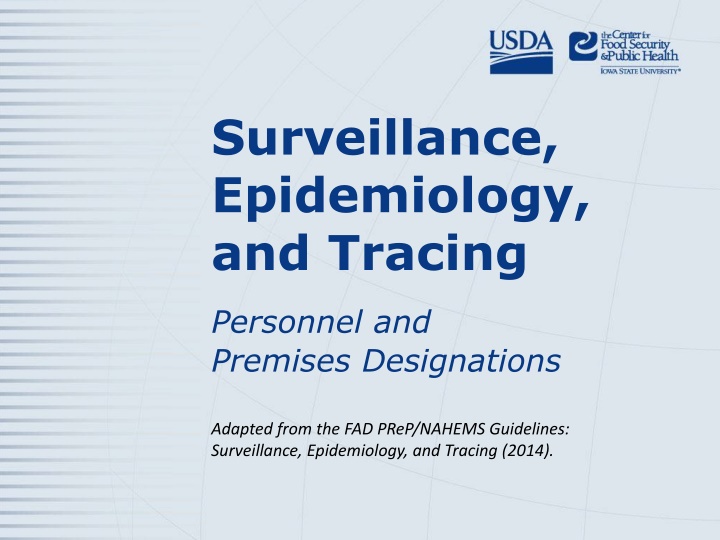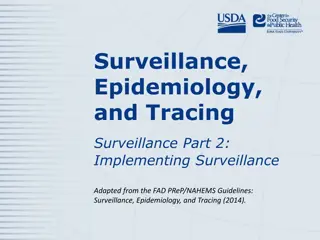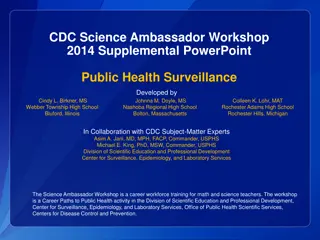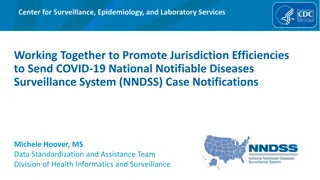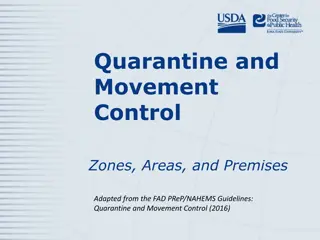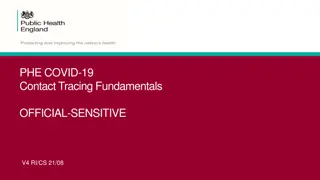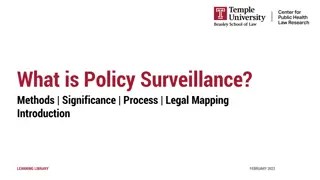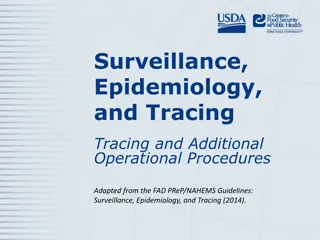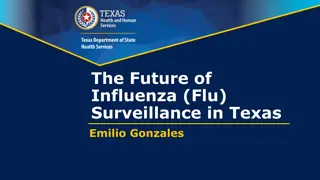Guidelines for Surveillance, Epidemiology, and Tracing Personnel and Premises Designations
This presentation provides an overview of necessary personnel, incident command, planning sections, and premises designations based on the FAD PReP/NAHEMS Guidelines for Surveillance, Epidemiology, and Tracing. It covers topics such as the Incident Command System, Planning Section, and Operations Section for effective response to disease outbreaks.
Download Presentation

Please find below an Image/Link to download the presentation.
The content on the website is provided AS IS for your information and personal use only. It may not be sold, licensed, or shared on other websites without obtaining consent from the author.If you encounter any issues during the download, it is possible that the publisher has removed the file from their server.
You are allowed to download the files provided on this website for personal or commercial use, subject to the condition that they are used lawfully. All files are the property of their respective owners.
The content on the website is provided AS IS for your information and personal use only. It may not be sold, licensed, or shared on other websites without obtaining consent from the author.
E N D
Presentation Transcript
Surveillance, Epidemiology, and Tracing Personnel and Premises Designations Adapted from the FAD PReP/NAHEMS Guidelines: Surveillance, Epidemiology, and Tracing (2014).
This Presentation Overview of necessary personnel Incident Command Planning Section Operations Section Premises, zones, and area designations FAD PReP/NAHEMS Guidelines: Surveillance, Epi, and Tracing - Personnel Premises USDA APHIS and CFSPH
Personnel FAD PReP/NAHEMS Guidelines: Surveillance, Epi, and Tracing - Personnel Premises USDA APHIS and CFSPH
Incident Command System Incident Command System (ICS) Flexible and scalable Number and names of deployed groups will vary Planning and Operations Sections Incident Action Plan FAD PReP/NAHEMS Guidelines: Surveillance, Epi, and Tracing - Personnel Premises USDA APHIS and CFSPH
Planning Section FAD PReP/NAHEMS Guidelines: Surveillance, Epi, and Tracing - Personnel Premises USDA APHIS and CFSPH
Planning Section Situation Unit Disease Reporting Cell Formulates daily surveillance activities Summarize and organize data Epidemiology Cell Analyzes data Plans outbreak response FAD PReP/NAHEMS Guidelines: Surveillance, Epi, and Tracing - Personnel Premises USDA APHIS and CFSPH
Operations Section FAD PReP/NAHEMS Guidelines: Surveillance, Epi, and Tracing - Personnel Premises USDA APHIS and CFSPH
Operations Section Disease Surveillance Branch consists of four groups: Mortality Surveillance Group Diagnosis and Inspection Group Disease Survey Group Tactical Epidemiology Group FAD PReP/NAHEMS Guidelines: Surveillance, Epi, and Tracing - Personnel Premises USDA APHIS and CFSPH
Groups in Operations Mortality Surveillance Group Collects and samples dead animals from farms to survey for presence of a disease agent Diagnosis and Inspection Group Conducts investigations and sampling to survey for the presence of the disease agent FAD PReP/NAHEMS Guidelines: Surveillance, Epi, and Tracing - Personnel Premises USDA APHIS and CFSPH
Groups in Operations (contd) Disease Survey Group Determines which premises within Control Area have susceptible species Collects Global Positioning System (GPS) information for each premises Tactical Epidemiology Group Conducts tracing activities Conducts field investigations Inputs and extracts outbreak associated data from the electronic database FAD PReP/NAHEMS Guidelines: Surveillance, Epi, and Tracing - Personnel Premises USDA APHIS and CFSPH
Premises, Zones, and Area Designations FAD PReP/NAHEMS Guidelines: Surveillance, Epi, and Tracing - Personnel Premises USDA APHIS and CFSPH
Premises Designations The premises designations are: Infected Premises Contact Premises Suspect Premises At-Risk Premises Monitored Premises Free Premises Vaccinated Premises FAD PReP/NAHEMS Guidelines: Surveillance, Epi, and Tracing - Personnel Premises USDA APHIS and CFSPH
Premises Designations (contd) Infected Premises Presumptive or confirmed positive based on lab results, compatible clinical signs, case definition, and international standards Contact Premises Exposed susceptible animals - either directly or indirectly to animals, animal products, fomites, or people from Infected Premises FAD PReP/NAHEMS Guidelines: Surveillance, Epi, and Tracing - Personnel Premises USDA APHIS and CFSPH
Premises Designations (contd) Suspect Premises Under investigation - susceptible animals reported to have clinical signs compatible with the FAD At-Risk Premises Susceptible animals no clinical signs compatible with the FAD. May seek to move susceptible animals or products within the Control Area by permit FAD PReP/NAHEMS Guidelines: Surveillance, Epi, and Tracing - Personnel Premises USDA APHIS and CFSPH
Premises Designations (contd) Monitored Premises Demonstrates that it is not an Infected, Contact, or Suspect Premises. Meets criteria to move susceptible animals or products out of the Control Area by permit. Free Premises Outside of a Control Area - not a Contact or Suspect Premises Vaccinated Premises Emergency vaccination has been performed FAD PReP/NAHEMS Guidelines: Surveillance, Epi, and Tracing - Personnel Premises USDA APHIS and CFSPH
Premises Locations FAD PReP/NAHEMS Guidelines: Surveillance, Epi, and Tracing - Personnel Premises USDA APHIS and CFSPH
Zones and Areas Summary of Zone and Area Designations Infected Zone (IZ) Zone that immediately surrounds an infected Premises. Zone that immediately surrounds and Infected Zone or Contact Premises Buffer Zone (BZ) Consists of an Infected Zone and Buffer Zone Control Area (CA) Surveillance Zone (SZ) Vaccination Zone (VZ) Zone outside and along the border of a Control Area Emergency Vaccination Zone is classified as either Containment Vaccination Zone (typically inside the control area) or Protection Vaccination Zone (typically outside Control Area). This may be secondary zone designation FAD PReP/NAHEMS Guidelines: Surveillance, Epi, and Tracing - Personnel Premises USDA APHIS and CFSPH
Premises, Zones, and Areas FAD PReP/NAHEMS Guidelines: Surveillance, Epi, and Tracing - Personnel Premises USDA APHIS and CFSPH
Minimum Sizes Control Area Numerous factors determine size Varies according to FAD agent and circumstances of the outbreak Minimum sizes established for: Infected Zone Buffer Zone Control Area Surveillance Zone FAD PReP/NAHEMS Guidelines: Surveillance, Epi, and Tracing - Personnel Premises USDA APHIS and CFSPH
For More Information FAD PReP/NAHEMS Guidelines: Surveillance, Epidemiology, and Tracing, and SOP: Surveillance http://www.aphis.usda.gov/fadprep Surveillance, Epidemiology, and Tracing web-based training module http://naherc.sws.iastate.edu/ FAD PReP/NAHEMS Guidelines: Surveillance, Epi, and Tracing - Personnel Premises USDA APHIS and CFSPH
Guidelines Content Authors (CFSPH) Kerry Leedom Larson, DVM, MPH, PhD, DACVPM Glenda Dvorak, DVM, MPH, DACVPM Janice Mogan, DVM Courtney Blake, BA Reviewers (USDA APHIS VS) Dr. R. Alex Thompson Dr. Lowell Anderson Dr. Steve Goff Dr. Fred Bourgeois FAD PReP/NAHEMS Guidelines: Surveillance, Epi, and Tracing - Personnel Premises USDA APHIS and CFSPH
Acknowledgments Development of this presentation was by the Center for Food Security and Public Health at Iowa State University through funding from the USDA APHIS Veterinary Services PPT Authors: Patricia Futoma, Veterinary Student; Kerry Leedom Larson, DVM, MPH, PhD, DACVPM Reviewers: Janice Mogan, DVM, Melissa Lang, BS
